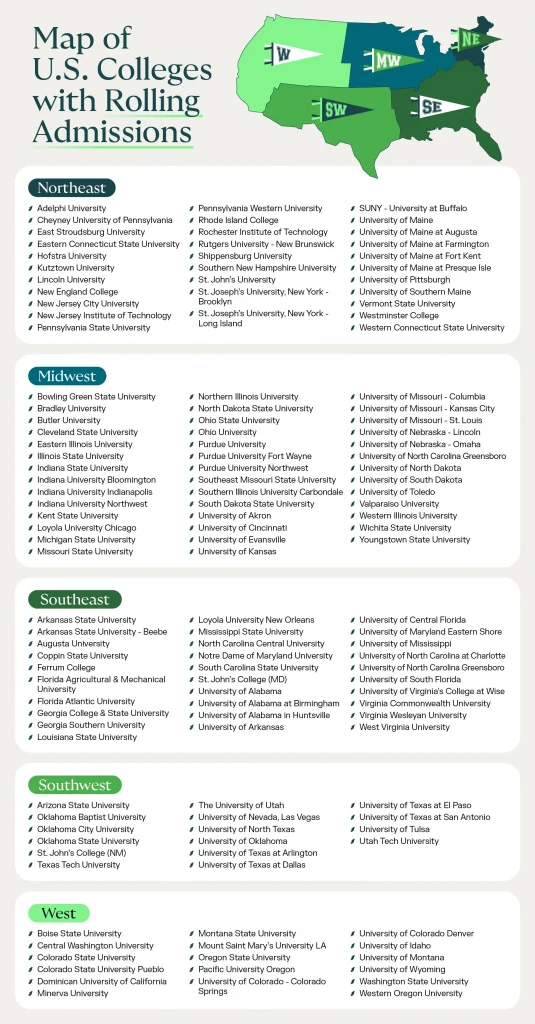For many students, the traditional fall application cycle can feel rushed and overwhelming. Fortunately, a significant number of colleges across the U.S. offer rolling admissions — a more flexible approach. Keep reading to learn more about rolling admissions and the numerous schools that utilize this system, providing you with more control over your application timeline.
Introduction to Rolling Admissions
Rolling admissions is a college admissions option where institutions review applications as they receive them, rather than waiting for a single deadline. Colleges continuously review applications and release admissions decisions until they fill the class. This process typically takes place from September through May. While rolling admissions is a flexible option, students need to apply as early as possible to ensure not only a spot in the class, but more financial aid and housing options.
So, how do rolling admissions work? As soon as a student submits a complete application, the admissions committee begins its evaluation. Decisions are then released on an ongoing basis, usually four to six weeks after the application is received. Think of it as a continuous flow rather than a single wave.
Benefits of Rolling Admissions
Rolling admissions can offer several advantages for students:
- Earlier decisions: One of the biggest perks is the possibility of receiving an admission decision much earlier than with traditional deadlines. This can reduce anxiety and allow students more time to plan their next steps, including exploring financial aid options and making housing arrangements.
- More time to prepare: Knowing earlier where you’ve been accepted can alleviate the pressure of juggling multiple application deadlines simultaneously. You might be able to focus your energy on fewer remaining applications or on preparing for the colleges where you’ve already gained admission.
- Potential for scholarship consideration: Some universities with rolling admissions also award scholarships on a rolling basis. Applying early might increase your chances of being considered for these limited funds.
- Flexibility: If your senior year schedule is demanding or if unforeseen circumstances arise, the rolling admission process offers more flexibility in when you can complete and submit your application.
- Opportunity to improve applications: If you apply early to a rolling admissions school and aren’t accepted, you might have time to strengthen your application profile before applying to other institutions with later deadlines.
Rolling Admissions vs. Traditional Admissions
The key difference between rolling admissions and traditional admissions lies in the timing of application review and decision release.
Traditional admissions: Colleges with traditional admissions have specific application deadlines (e.g., Early Action, Early Decision, Regular Decision). All applications received by these deadlines are reviewed together after the deadline has passed. Admission decisions are then released on a specific date. This creates a more concentrated period of application work for students and a longer wait for decisions.
Rolling admissions: As mentioned earlier, applications are reviewed and decisions are made continuously. There isn’t one big deadline, although many rolling admissions schools have a suggested priority deadline. Applying by this priority date often maximizes your chances for admission and financial aid.
Rolling Admissions for International Students
Generally, the core mechanics of rolling admissions remain the same for international students. However, there are some nuances to be aware of, such as visa processing times, transcript evaluations, English language proficiency tests, and different deadlines and priority dates. The added complexities of international applications make early application within the rolling window even more critical.
Ultimate List of Schools with Rolling Admissions
This list reflects a broad range of institutions across the U.S. that commonly utilize a rolling admissions policy, whether you’re interested in attending a private or state university. Keep in mind that it’s always best to check the specific admissions website of each college for the most up-to-date information on their application process and deadlines, as some have priority deadlines or may fill up spaces.

It’s important to understand each school’s rolling admission policy. Some institutions use traditional admissions for fall term entry and rolling for spring and summer terms. Others only accept applications on a rolling basis after the traditional admissions process is completed, so long as space is still available in certain programs.
Leveraging Rolling Admissions
Rolling admissions can be a great opportunity to maximize your chances of getting into your desired colleges. Here are three tips for effectively leveraging the rolling admissions process:
- Apply early when there are more available spots in the class, as well as better financial aid and housing opportunities. This not only increases your chances of acceptance, but you’ll receive an admissions decision sooner, giving you more time to plan.
- Take advantage of the flexibility that rolling admissions offers. While applying early is ideal, you also have more time to improve grades and test scores if you need it. Additionally, you can spend more time improving other components of your application since you aren’t rushed.
- Apply to multiple schools with rolling admissions without worrying about conflicting deadlines. This allows you to keep your options open and potentially receive multiple offers.
Understanding the Application Process for Rolling Admissions
The application requirements for colleges with rolling admissions are typically the same as the traditional admissions process. Here are the key steps:
- Research colleges with rolling admissions to identify those that align with your academic, financial, and personal preferences.
- Understand individual college requirements and deadlines (especially priority deadlines).
- Gather the necessary application materials — typically, these are the same as colleges with traditional deadlines: application form, transcripts, standardized test scores, letters of recommendation, essays, and application fee (if applicable).
- Submit your application. Don’t forget to review before submitting to ensure it’s error-free and that you have completed all the requirements.
- Track your application status. Most colleges provide an online portal where you can track the status of your application and see if any required materials are missing.
- Await the admission decision. Colleges with rolling admissions typically send out decisions on a rolling basis, often within a few weeks of receiving a complete application.
- Review your admission offer and financial aid package. If you are admitted, carefully review the terms of admission, any scholarship offers, and the overall financial aid package.
- Make your decision and notify the college. You will often be given a deadline to make your final decision and notify the college of your enrollment.
- Complete enrollment paperwork and pay enrollment deposit.
Common Mistakes to Avoid
By being aware of these common mistakes, you can approach the rolling admissions process strategically and increase your chances of a successful outcome:
- Failing to do your research: Just because a school has rolling admissions doesn’t mean you shouldn’t research its programs, culture, and values to ensure it’s a good fit for you. Your “Why this college?” (even if implicit) should still be evident in your application.
- Assuming rolling admission means less competitive: Don’t underestimate the competition. Your application still needs to be strong and showcase your qualifications effectively.
- Not considering demonstrated interest (if applicable): While not always a major factor in rolling admissions, showing interest through campus visits (if possible), attending virtual events, or engaging with admissions representatives can sometimes be a subtle positive.
- Waiting too long to ask for letters of recommendation: Give your recommenders ample time (at least a month) to write thoughtful letters. Don’t ask them at the last minute.
- Procrastinating on applying: Ideally, you should apply in the fall of your senior year — yes, even for rolling admissions.
- Submitting a hasty or rushed application: Don’t sacrifice quality for speed! Have multiple people proofread your entire application before submitting.
- Ignoring priority deadlines: Missing priority deadlines can mean missing out on scholarships, honors programs, and sometimes even admission to competitive programs.
- Submitting an incomplete application: If you’re missing transcripts, test scores, recommendations, or the application fee, your application won’t be reviewed, delaying your decision and potentially hindering your chances.
- Not tailoring essays: If a school asks for a specific essay or has supplemental questions, treat it with the same care and customization as you would for an early or regular application.
- Not planning for financial aid early: Even with rolling admission, start the financial aid process (FAFSA, CSS Profile, institutional aid applications) as early as possible. Financial aid funds can be limited.
- Not visiting the campus (if possible) before committing: If you receive an early acceptance, try to visit the campus before making your final decision to ensure it’s the right environment for you.
- Ignoring deadlines for admitted students: Once accepted, pay close attention to deadlines for accepting the offer, submitting housing forms, and other required paperwork.
Rolling Admissions vs. Early Decision and Regular Decision
College admissions processes vary significantly across institutions, with three primary approaches dominating the landscape: rolling admissions, Early Decision, and Regular Decision. Understanding the distinctions between these processes is crucial for students navigating their college application journey.
Understanding the Three Admission Processes
Rolling admissions operates on a first-come, first-served basis, where colleges review and respond to applications as they arrive throughout an extended application period, typically from fall through spring or even summer. Students can apply at any point during this window and receive decisions within weeks of submitting their materials.
Early Decision, conversely, requires students to submit applications by an early deadline (usually November 1 or 15) and represents a binding commitment to attend if accepted.
Regular Decision follows traditional college application deadlines, typically in January, with decisions released in March or April, giving students until May 1st to make their final college choice.
Advantages and Disadvantages for Students
Rolling admissions offers several compelling advantages for students. The flexible timeline reduces stress by allowing applications throughout an extended period, while quick turnaround times provide early peace of mind. Students can secure acceptances early in their senior year, potentially reducing the total number of applications needed. Additionally, applying early in the rolling cycle can improve admission chances, as spaces become more competitive as the deadline approaches. However, rolling admissions has notable drawbacks: Procrastination can significantly hurt chances as slots fill up, and the pressure to submit applications quickly may result in less polished materials.
Early Decision provides strategic advantages for students with a clear first-choice school. The binding nature demonstrates strong commitment to the institution, often resulting in higher acceptance rates compared to Regular Decision pools. Students receive decisions by late December, allowing them to focus on other applications if rejected or celebrate early acceptance. The primary disadvantage is the binding commitment itself, which prevents students from comparing financial aid packages across multiple schools. This can be particularly problematic for families needing substantial financial assistance, as they cannot leverage competing offers.
Regular Decision offers maximum flexibility and time for preparation. Students can craft stronger applications with additional months of academic performance, extracurricular achievements, and essay refinement. They can compare multiple acceptance offers and financial aid packages before making their final decision. The main disadvantages include potentially lower acceptance rates at competitive schools, extended stress throughout senior year, and the risk of missing out on schools with rolling admissions that may fill up by Regular Decision deadlines.
Matching Admission Processes to Student Types
Different admission processes suit various student profiles and circumstances:
- Rolling admissions works exceptionally well for organized, proactive students who can prepare quality applications early in their senior year. These students often have clear preferences for less competitive schools or state universities that commonly use rolling admissions. Students with strong academic profiles who apply early in the rolling cycle can maximize their advantages, while those who need extra time or tend to procrastinate should approach rolling admissions with caution.
- Early Decision is ideal for students who have identified a clear first-choice school through thorough research and campus visits. These students typically have competitive academic profiles and are committed to enrolling if they are accepted. However, Early Decision is best suited for families who either don’t require significant financial aid or are confident in their ability to afford their first-choice school regardless of the aid package. Students who need to compare financial offers should generally avoid applying to colleges Early Decision.
- Regular Decision serves students who need maximum flexibility in their college choice or additional time to strengthen their applications. This process works well for students applying to highly competitive schools where Early Decision may not provide significant advantages, those who need to compare financial aid packages carefully, or students whose academic performance or extracurricular involvement is still developing throughout senior year. International students and those with complicated family financial situations often benefit most from the Regular Decision timeline and flexibility.
Financial Aid and Scholarships for Rolling Admissions
Understanding how rolling admissions intersects with financial aid and scholarship opportunities is crucial for students seeking to maximize their college affordability. While rolling admissions offers flexibility in application timing, it also presents unique considerations for financial assistance that differ significantly from traditional admission cycles.
Impact of Rolling Admissions on Financial Aid and Scholarships
Rolling admissions can both positively and negatively affect financial aid opportunities, depending largely on application timing and institutional policies. Students who apply early in the rolling cycle often benefit from better financial aid availability, as colleges typically allocate aid on a first-come, first-served basis alongside admissions decisions. Merit-based scholarships, in particular, tend to favor early applicants since institutions use these awards to attract their most desirable candidates early in the cycle. However, the decentralized nature of rolling admissions can complicate financial aid processing, as families may receive aid offers at different times throughout the year, making comparison more challenging than with traditional spring notification dates.
The timing advantage of early rolling applications extends beyond simple availability of funds. Top colleges with rolling admissions in the U.S. often provide preferential packaging to students who demonstrate early interest and commitment. These institutions may offer more generous aid combinations or priority consideration for competitive scholarships to students who apply months before the final deadline. Conversely, students who wait until later in the rolling cycle may find that institutional grant money has been largely distributed, leaving them with aid packages more heavily weighted toward loans or work-study programs.
Available Financial Aid Resources
Students applying through rolling admissions have access to the same fundamental financial aid resources as those in traditional admission cycles, though the timing and process may differ. Federal financial aid for college students remains the cornerstone of most aid packages, including Pell Grants, Federal Direct Loans, and Federal Work-Study programs. The FAFSA (Free Application for Federal Student Aid) timeline remains consistent regardless of admission type, with the form becoming available on October 1 for the following academic year. Students should complete the FAFSA as early as possible, ideally by the priority deadlines established by individual institutions, which often fall between February and April.
Institutional aid represents a significant component of financial assistance for rolling admissions students. Many colleges with rolling admissions are public universities or regional institutions that offer substantial need-based grants and merit scholarships specifically designed for their applicant pool. These schools often maintain separate scholarship applications with their own deadlines, which may differ from admission deadlines. State-based financial aid programs also play a crucial role, particularly for students attending in-state public universities with rolling admissions. These state grants and scholarships for college students typically follow their own application timelines and eligibility requirements, independent of college admission processes.
Private scholarships and external funding sources remain equally available to rolling admissions applicants. National scholarship competitions, local community awards, and organization-specific grants operate on their own schedules, often with deadlines spread throughout the senior year. Students applying through rolling admissions may actually have advantages in pursuing external scholarships, as they can focus energy on scholarship applications after securing early college acceptances.
Maximizing Financial Aid Opportunities
Students can employ several strategic approaches to maximize their financial aid potential within rolling admissions systems:
- Early application submission cannot be overstated in importance. Applying within the first few weeks or months of the rolling cycle positions students for the best available financial aid packages. Applying early demonstrates interest to admissions committees and financial aid offices, often resulting in more favorable treatment in aid allocation decisions.
- Completing financial aid applications promptly and accurately significantly impacts aid availability. Students should submit the FAFSA immediately upon its October 1 release, using prior-year tax information to ensure accuracy. Following up with required documentation, such as tax returns, W-2 forms, and verification worksheets, should happen as quickly as possible. Many rolling admissions institutions process financial aid on a continuous basis alongside admissions decisions, meaning faster financial aid application completion can result in earlier and potentially more generous aid offers.
- Communication with financial aid offices proves particularly valuable for rolling admissions students. Unlike traditional admission cycles where aid information flows through established timelines, rolling admissions allows for more individualized attention and potentially more flexible aid arrangements. Students should not hesitate to contact financial aid offices with questions about deadlines, required documents, or aid packaging policies. Demonstrating financial need clearly and providing any relevant documentation about changed financial circumstances can help aid officers craft appropriate packages.
- Students should also maintain awareness of institutional scholarship deadlines, which may differ significantly from admission deadlines. Many rolling admissions schools require separate scholarship applications, often due earlier than admission applications themselves. Researching and tracking these various deadlines prevents students from missing opportunities due to timing confusion. Additionally, students should continue pursuing external scholarship opportunities throughout their senior year, as many private scholarships have deadlines extending into spring, allowing rolling admissions students to supplement their institutional aid packages with outside funding.
Tips for a Successful Rolling Admissions Application
Rolling admissions can offer a strategic advantage for college-bound students, but success requires understanding the unique dynamics of this college admissions process. Unlike traditional admissions with fixed deadlines, rolling admissions schools review applications as they arrive and make decisions continuously throughout the admissions cycle. This approach rewards early applicants while maintaining flexibility for those who need more time to prepare their materials.
The most crucial tip for rolling admissions success is to apply early in the cycle. Since colleges evaluate applications in the order they receive them, submitting your application in late summer or early fall significantly increases your chances of acceptance. Spots fill up as the year progresses, and standards often become more competitive as the applicant pool grows. Additionally, early applicants frequently receive priority consideration for merit scholarships and housing options. Students should also ensure their applications are complete and polished before submission, as there’s no benefit to applying early if your materials aren’t ready to make a strong impression.
For college application timeline planning, students should aim to submit rolling admissions applications between August and October of their senior year. Begin preparing application materials during the summer before senior year, including drafting essays, gathering letters of recommendation, and requesting transcripts.
Submit applications as soon as they open, typically in late summer, rather than waiting until traditional deadlines in winter or spring. This early submission strategy allows students to receive admissions decisions by late fall or early winter, providing peace of mind and the opportunity to focus on other applications or enjoy their senior year. Students should also remember that rolling admissions schools often continue accepting applications well into the spring, making them excellent backup options if other plans fall through.
Craft an Application Strategy with IvyWise
Preparing to apply to schools with rolling admissions offers you more flexibility than schools with application deadlines. However, there are distinct advantages to applying earlier in the cycle. IvyWise admissions counselors have 440+ years combined experience as former admissions officers at U.S. universities, so they are positioned to help you find your best-fit schools and develop a personalized strategy to help you get into your top colleges.
Get Started





